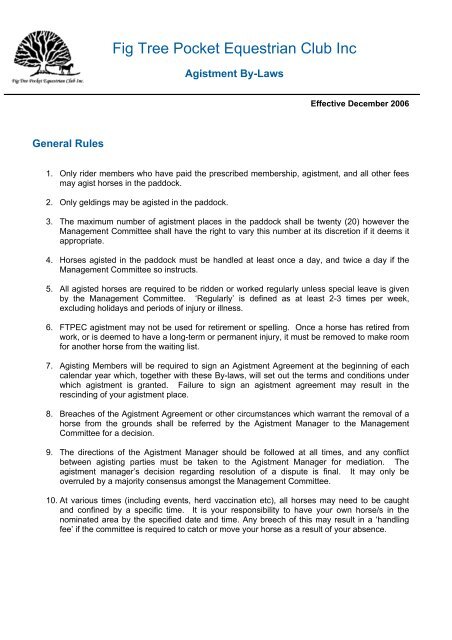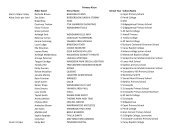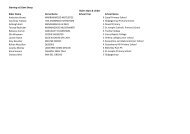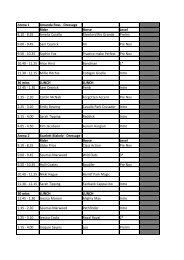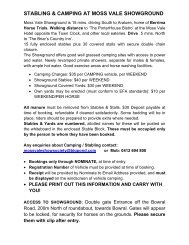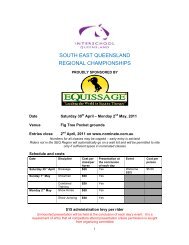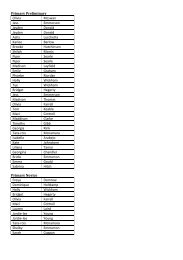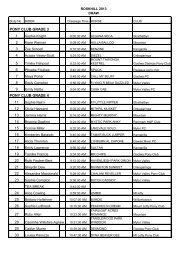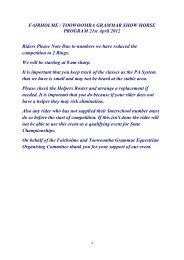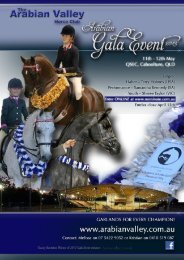Agistment By-Laws - Fig Tree Pocket Equestrian Club
Agistment By-Laws - Fig Tree Pocket Equestrian Club
Agistment By-Laws - Fig Tree Pocket Equestrian Club
You also want an ePaper? Increase the reach of your titles
YUMPU automatically turns print PDFs into web optimized ePapers that Google loves.
<strong>Fig</strong> <strong>Tree</strong> <strong>Pocket</strong> <strong>Equestrian</strong> <strong>Club</strong> Inc<br />
<strong>Agistment</strong> <strong>By</strong>-<strong>Laws</strong><br />
Effective December 2006<br />
General Rules<br />
1. Only rider members who have paid the prescribed membership, agistment, and all other fees<br />
may agist horses in the paddock.<br />
2. Only geldings may be agisted in the paddock.<br />
3. The maximum number of agistment places in the paddock shall be twenty (20) however the<br />
Management Committee shall have the right to vary this number at its discretion if it deems it<br />
appropriate.<br />
4. Horses agisted in the paddock must be handled at least once a day, and twice a day if the<br />
Management Committee so instructs.<br />
5. All agisted horses are required to be ridden or worked regularly unless special leave is given<br />
by the Management Committee. ‘Regularly’ is defined as at least 2-3 times per week,<br />
excluding holidays and periods of injury or illness.<br />
6. FTPEC agistment may not be used for retirement or spelling. Once a horse has retired from<br />
work, or is deemed to have a long-term or permanent injury, it must be removed to make room<br />
for another horse from the waiting list.<br />
7. Agisting Members will be required to sign an <strong>Agistment</strong> Agreement at the beginning of each<br />
calendar year which, together with these <strong>By</strong>-laws, will set out the terms and conditions under<br />
which agistment is granted. Failure to sign an agistment agreement may result in the<br />
rescinding of your agistment place.<br />
8. Breaches of the <strong>Agistment</strong> Agreement or other circumstances which warrant the removal of a<br />
horse from the grounds shall be referred by the <strong>Agistment</strong> Manager to the Management<br />
Committee for a decision.<br />
9. The directions of the <strong>Agistment</strong> Manager should be followed at all times, and any conflict<br />
between agisting parties must be taken to the <strong>Agistment</strong> Manager for mediation. The<br />
agistment manager’s decision regarding resolution of a dispute is final. It may only be<br />
overruled by a majority consensus amongst the Management Committee.<br />
10. At various times (including events, herd vaccination etc), all horses may need to be caught<br />
and confined by a specific time. It is your responsibility to have your own horse/s in the<br />
nominated area by the specified date and time. Any breech of this may result in a ‘handling<br />
fee’ if the committee is required to catch or move your horse as a result of your absence.
Selection Criteria<br />
11. <strong>Agistment</strong> places shall be allocated to Members (to be known as Agisting Members) by the<br />
Management Committee, which shall have sole discretion to determine priorities for allocating<br />
spaces. Priority may be given to riders who display a high level of commitment to the sport, or<br />
have good references from their previous club. In cases where a prospective candidate is<br />
unknown to FTPEC, the committee will interview the candidate in an effort to determine<br />
suitability.<br />
12. Horses may only be brought into the paddock following the Management Committee’s<br />
approval of a written request for agistment.<br />
13. At times when the demand for places exceeds the number of spaces available, FTPEC shall<br />
keep a register of applications for agistment, which shall form an official ‘Waiting List’.<br />
14. When a place becomes available, the Management Committee shall consider all applications<br />
on the waiting list, taking into account any circumstances that the Committee deems relevant.<br />
The Committee may refuse agistment to any applicant for any reason, especially if it believes<br />
it to be in the best interest of the existing herd.<br />
15. An applicant for an agistment place shall be informed in writing by the <strong>Agistment</strong> Manager or<br />
other office bearer of the <strong>Club</strong>, of the outcome of their application.<br />
16. If an agisted horse is sold to a member who does not have an agistment place, that member<br />
may be required to remove the horse and apply for a place in accordance with the provisions<br />
of by-laws 11-14.<br />
17. If an agisted horse is leased to another member, the agistment place remains with the owner<br />
of the horse and does not go to the lessee.
Bringing in a Horse<br />
18. Before entry to the paddock, horses must be treated, wormed and vaccinated against<br />
strangles and tetanus, and certificates to this effect must be presented if requested.<br />
19. New horses must spend a minimum of four (4) days (96 hours) confined in either the yards or<br />
a holding paddock, the location to be determined by the <strong>Agistment</strong> Manager. Under no<br />
circumstances may horses be released directly into the paddocks before this time.<br />
20. During the four-day period, other Agisting Members will be advised of the proposed date to<br />
release the new horse. The agistment manager must be given at least 48 hours prior notice of<br />
the exact release date and time so that the other agistees may be informed.<br />
21. Owners of newly released horses must remain in the vicinity for a reasonable period in order<br />
to intervene and remove the horse in the event of trouble.<br />
22. All new horses shall be on probation for three months, or such time as the Management<br />
Committee determines. During this period the horse’s agistment may be rescinded by the<br />
Committee for any reason, especially those of safety to other horses or people.<br />
23. Horses that re-enter the paddock after an absence of thirty days or more shall be treated as if<br />
they are new horses and their owners shall observe the provision of by-laws 19-21.<br />
24. The Management Committee has the right to request the removal of horses that exhibit<br />
unacceptable behaviour towards other horses, agistees or any persons in the paddock.<br />
25. The Management Committee has the power to require the removal of any horse at any time<br />
on reasonable notice. The Committee may direct that a horse be held in the yards or holding<br />
paddock pending its removal.<br />
26. An Agisting Member who wishes to agist a newly purchased horse may do so with the<br />
permission of the Management Committee. Written application to bring in the new horse is<br />
still required in accordance with the provision of by-law 12.<br />
27. A member who removes or sells an agisted horse from the paddock may, if actively looking for<br />
a new horse, hold their existing space for up to three (3) months by continuing to pay<br />
agistment fees. The Management Committee may extend this period at its discretion. If no<br />
suitable horse is found and other applicants are waiting, the Committee may reallocate the<br />
place.<br />
28. <strong>Agistment</strong> fees are payable from the date the place is made available, and are paid per<br />
quarter in advance. Unpaid agistment fees may result in the loss of your horse’s agistment<br />
place.<br />
29. When an agistee leaves, the remaining amount of their agistment shall be refunded. The<br />
refund will be pro-rated to the number of days remaining for the paid quarter, minus any other<br />
monies owing to the club.
Yard & Paddock Rules<br />
30. The <strong>Agistment</strong> Manager is delegated the authority and responsibility for day to day agistment<br />
on the grounds including management of the yards and horse care.<br />
31. The yard area must be kept tidy. Rugs are at risk if left in the yard area. Members do so at<br />
their own risk. If rugs are left in the area they should be hung neatly on the fence. Buckets<br />
and feed bins are to be cleaned daily and kept in a neat and tidy manner. Belongings should<br />
not be left lying around tin the general area.<br />
32. No structural modifications to the yards may be made without first obtaining the consent of the<br />
committee. This includes removing rails between adjacent yards, or any other alterations.<br />
33. Agisting Members may from time to time be required to contribute to the upkeep of the<br />
paddock or yards by way of a financial levy; the amount of such levy to be determined at a<br />
General Meeting of the club on the recommendation of the Management Committee.<br />
34. All senior agistees, and parents of junior agistees, are expected to assist with paddock and<br />
yard maintenance.<br />
35. Agistees may choose their own yards to use from those that are available. An agistee’s yard<br />
must then be kept clean and maintained. The agistee is responsible for keeping in good<br />
order, and arranging repairs for, any damage caused by their horse.<br />
36. From time to time the <strong>Agistment</strong> Manager will provide a list of duties to be undertaken each<br />
week by the agistees. This may include duties such as mowing, manure removal, or cleaning<br />
the water trough.<br />
37. Whenever an event is taking place, all horses agisted in the paddock must, be moved to the<br />
designated containment area (specified by the committee), or confined to their yards.<br />
38. Agistees are entitled to retain the use of their regular yard (without payment) during homebased<br />
events. They are not required to vacate their yard for external competitors.
Veterinary Care<br />
39. Care of the horse is paramount. If the <strong>Agistment</strong> Manager believes an agistee displays a lack<br />
of care toward their horse, the matter must be rectified immediately. If the problem persists,<br />
the committee may issue a written warning.<br />
40. All agisted horses are to be pasted at 3-monthly intervals, and vaccinated once a year<br />
(vaccination to coincide with one pasting). The day for pasting each quarter and the day and<br />
time for vaccinating will be advised by the <strong>Agistment</strong> Manager. Agistees will pay the costs of<br />
their worming paste and vaccination.<br />
41. Care of the herd is everyone’s responsibility. If a horse is found injured, every effort should be<br />
made to contact the owner as soon as possible. In the event that the injury is serious and the<br />
owner is uncontactable, a veterinary surgeon may be called to treat the injury, and the invoice<br />
passed to the owner.<br />
42. If your horse suffers an injury or illness which requires it to be temporarily separated from the<br />
herd, you may isolate your horse in any unoccupied hospital yard. You should then notify the<br />
<strong>Agistment</strong> Manager of the injury and the expected recovery time. If the number of injured<br />
horses exceeds the number of available yards, the <strong>Agistment</strong> Manager should be contacted to<br />
arrange an equitable solution. The <strong>Agistment</strong> Manager may seek veterinary advice to assist in<br />
his/her evaluation of the situation.<br />
43. If at any time your horse is diagnosed with a contagious illness of any kind, the <strong>Agistment</strong><br />
Manager must immediately be notified. At the <strong>Agistment</strong> Manager’s discretion, your horse<br />
may be isolated in a separate paddock during the infectious period.<br />
44. Under No Circumstances is a horse ever to be placed in a yard/paddock where another horse<br />
is already convalescing. If you wish your horse to share a space with another injured horse,<br />
approval must first be obtained from the owner of the other horse, and then the <strong>Agistment</strong><br />
Manager notified of the consensus.<br />
45. In the interests of the health and safety of the herd, the agistee gives FTPEC the right to<br />
contact your vet to discuss details of any injuries or ailments pertaining to your agisted horse,<br />
as well as the prognosis or estimated recovery period from any such illness or injury.<br />
46. Please Be Aware: It is reasonable to assume at any given time, that at least 2-3 horses in the<br />
herd may have a temporary condition requiring them to take medication prohibited according<br />
to the EFA’s Equine Anti-Doping and Medication Control rules (EADMC). It is the rider’s<br />
responsibility to avoid the risk of a positive swab from having their horse accidentally access<br />
another horse’s medication. FTPEC recommends that agistees close their yard after feeding,<br />
to help prevent other horses ingesting prohibited medication via leftover food belonging to a<br />
sick horse.
Riders with Two Horses<br />
47. Any rider member may agist only one horse in the paddock unless there are spare spaces, in<br />
which case the Management Committee may, at its sole discretion and upon conditions<br />
determined by the Committee, allow a member to agist more than one horse.<br />
a) The minimum prerequisite conditions for applying for a second horse are:<br />
i). the existing horse must be being ridden consistently 4-5 times per week, and<br />
ii). the horse/rider combination must be receiving weekly tuition with a certified instructor, and<br />
iii). the existing horse/rider combination must be competing regularly in EFA competitions.<br />
b) If a rider believes they meet the minimum requirements for owning a second horse, they must<br />
request permission from the Management Committee by following the same process required<br />
to bring in their original horse (refer to “Selection Criteria”).<br />
48. Agisting members who are approved to have more than one horse in the paddock, will be<br />
required to forego the place of one of their horses if the Management Committee determines<br />
that the following ongoing conditions are not met:<br />
i). both horses must be ridden regularly as defined in agistment by-law 5, and<br />
ii). the rider must receive regular tuition, on both horses, from a certified instructor, and<br />
iii). at least one of the two horses must be involved in regular EFA competition.<br />
49. For <strong>Agistment</strong> Members, working bees are calculated PER AGISTED HORSE as outlined in<br />
the Membership <strong>By</strong>-<strong>Laws</strong>. This means agistees with 2 horses are required to work twice the<br />
number of hours, or pay twice the exemption levy (or a combination of both).<br />
50. Be aware that all general agistment duties are calculated on a per-horse basis (e.g. mowing,<br />
manure removal etc).


